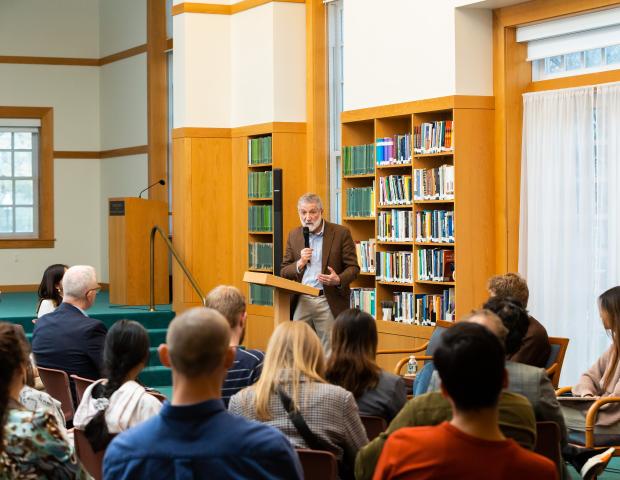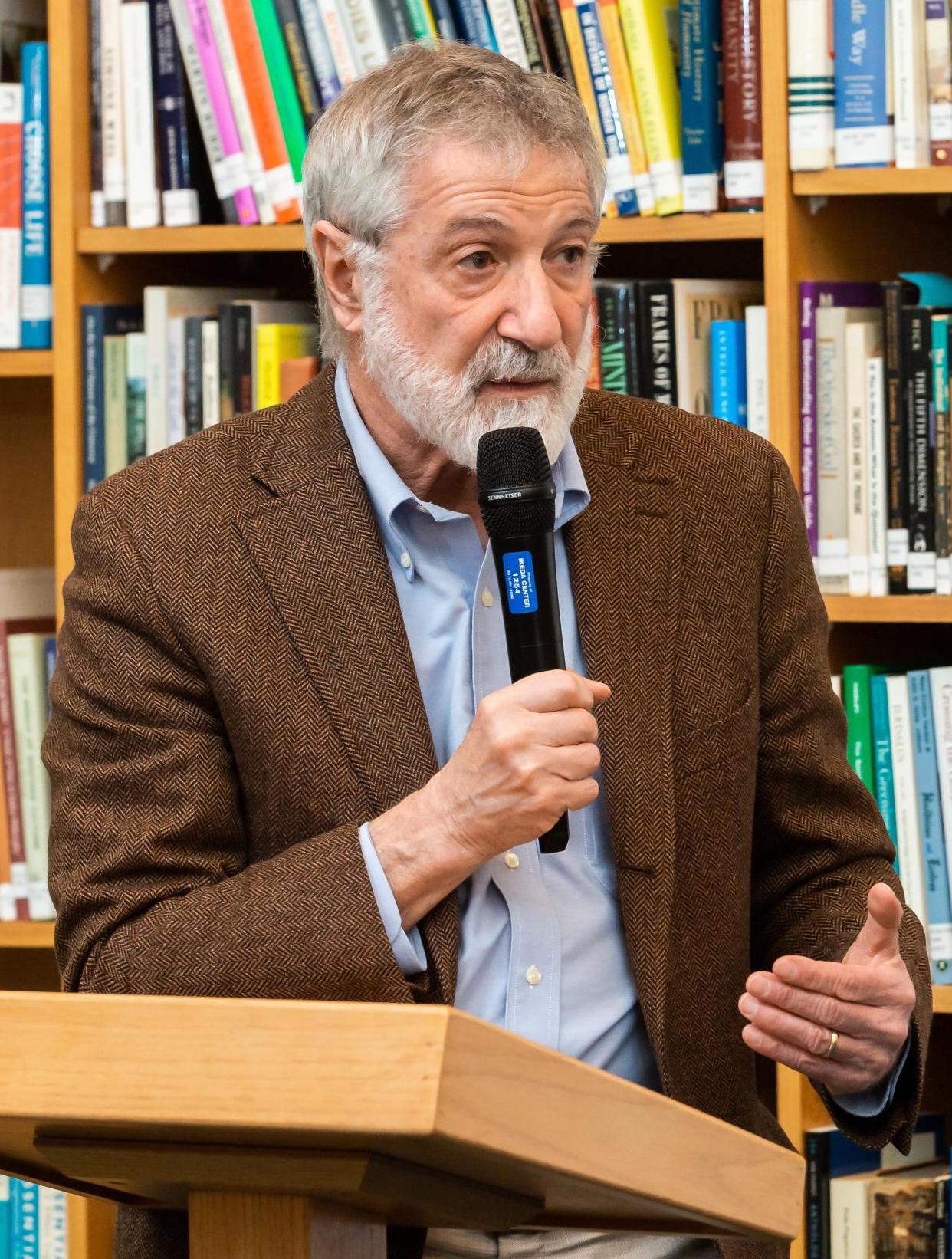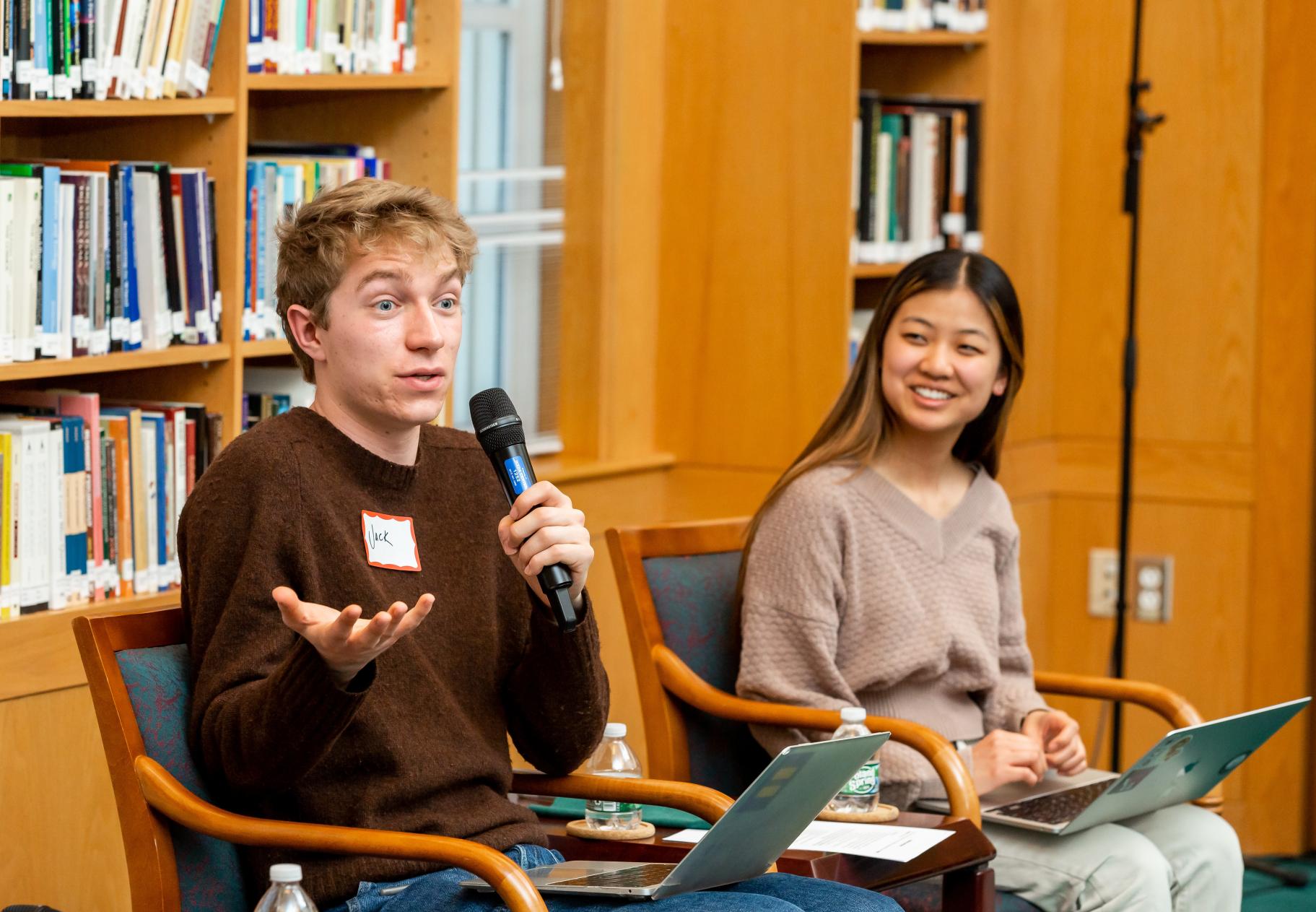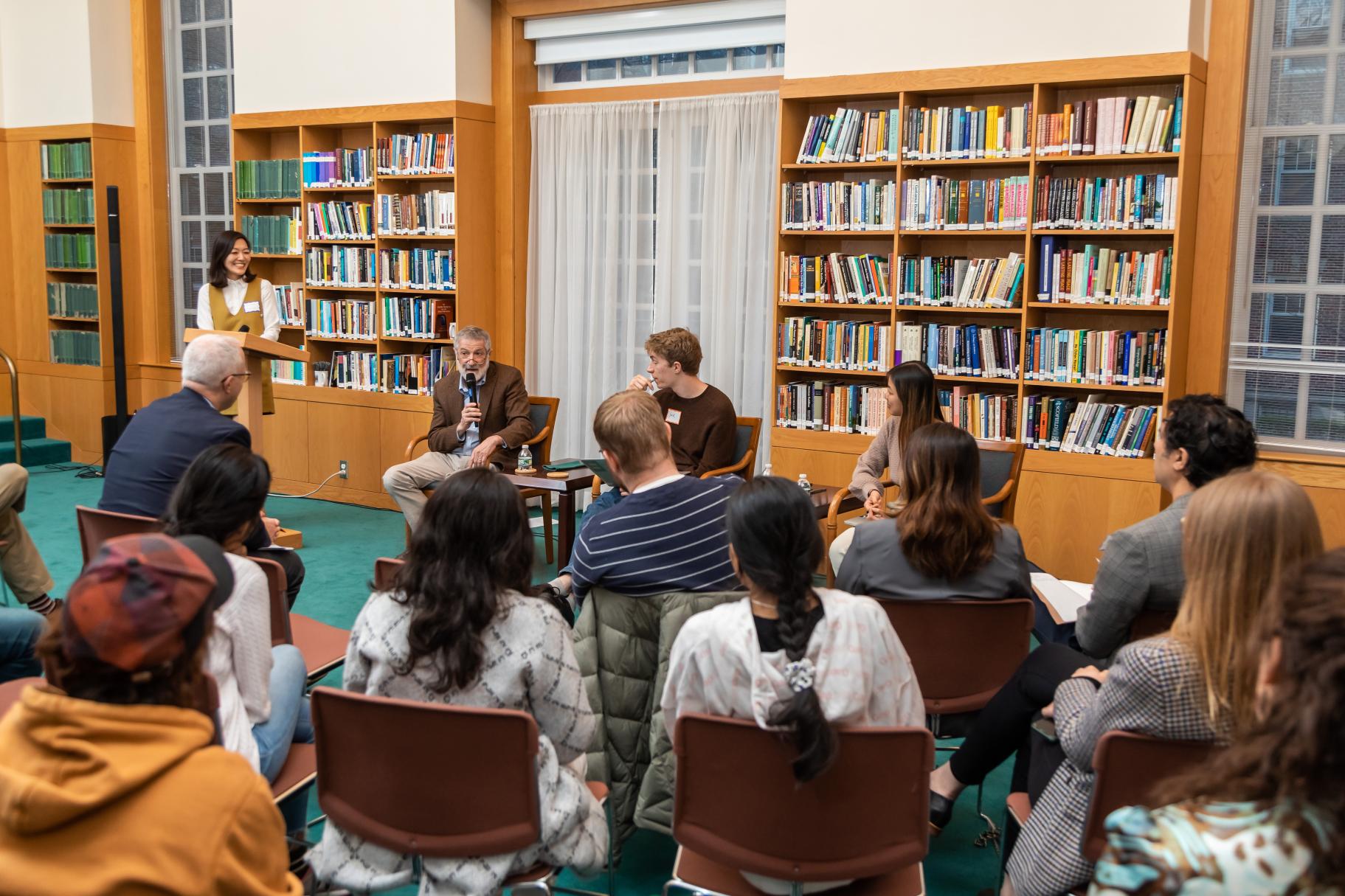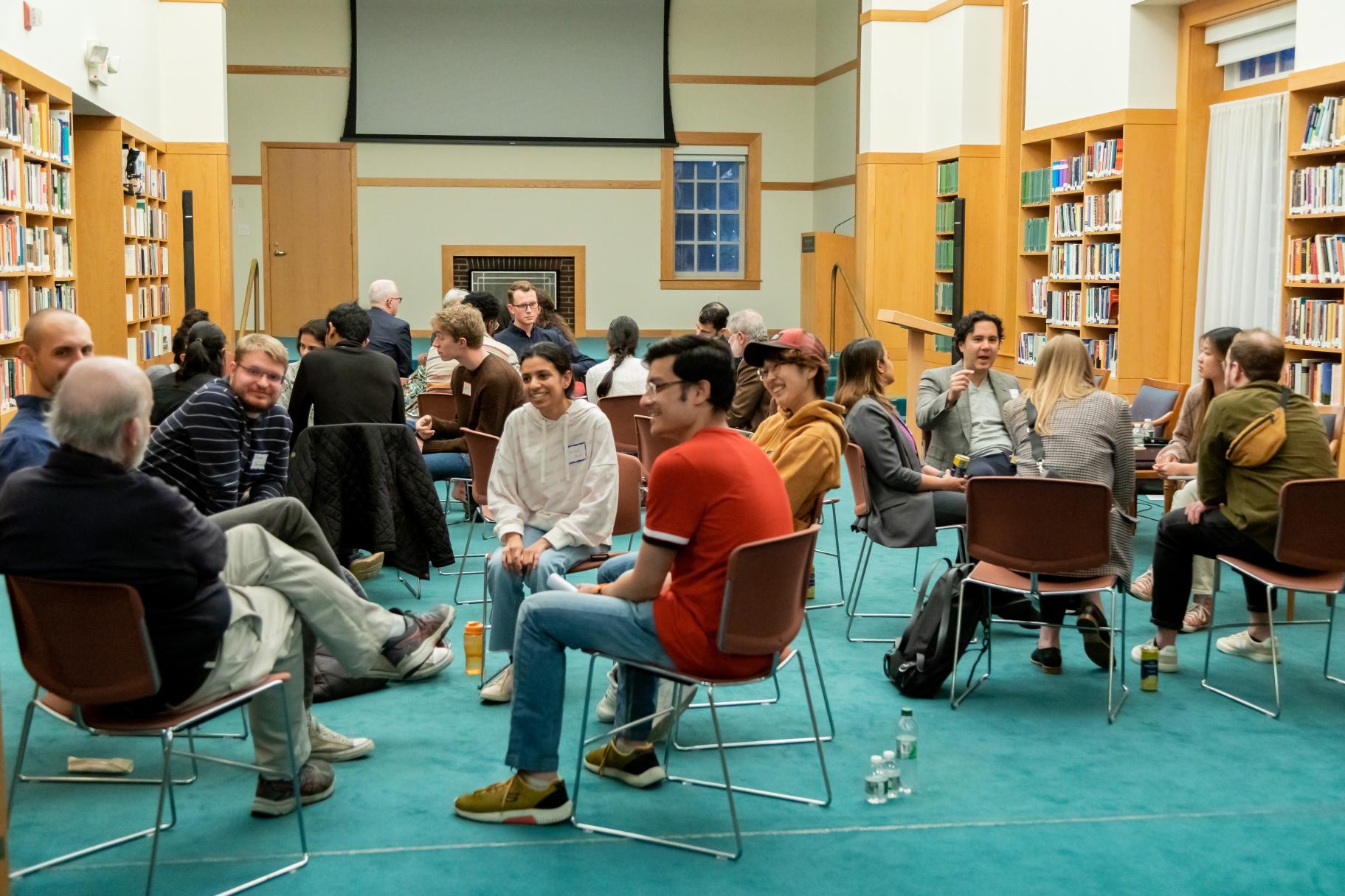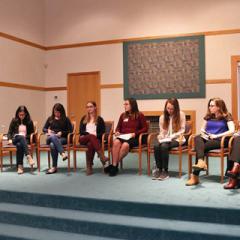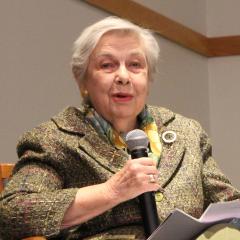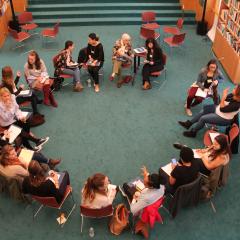Meeting the Challenge of Nuclear Weapons Abolition
Dr. Ira Helfand giving a powerful presentation at the event.
During his remarks at the Ikeda Center’s April 2023 dialogue event on nuclear disarmament, Dr. Ira Helfand effectively dispelled the notion that the threat of nuclear war is, as he put it, a “fantasy” or a “1980s problem,” a mere relic of the Cold War. He was joined in making the case for nuclear weapons abolition by Jack Trapanick and Emma Lu, student-activists at Harvard College. Called “Voices of Hope in a Critical Time: What Role Can We Play to Eliminate Nuclear Weapons?,” the event was co-sponsored by Greater Boston Physicians for Social Responsibility (GBPSR). This report is by Mitch Bogen.
Voices of Hope in a Critical Time: What Role Can We Play to Eliminate Nuclear Weapons?
During her welcoming remarks, Center program manager Lillian I explained how Center founder Daisaku Ikeda shares with GBPSR a long-term, unwavering commitment to this vital, life and death cause. Just 17 years old when the atomic bombs were dropped on Hiroshima and Nagasaki, Mr. Ikeda also experienced the death of his eldest brother during the war. Because of these experiences, he developed what he has described as “a deep hatred for war, its cruelty, stupidity and waste.” His devotion to nuclear disarmament in particular was sparked by his mentor, Josei Toda, who issued a Declaration Calling for the Abolition of Nuclear Weapons in 1957 in front of 50,000 Japanese youth, Ikeda among them. Toda’s stance, said Lillian, “was that nuclear weapons and their use must be absolutely condemned, not from the standpoint of ideology, nationality or ethnic identity but from the universal dimension of humanity and our inalienable right to live.” During the ensuing decades, Mr. Ikeda has woven the cause of nuclear disarmament into all of his peacebuilding work, including detailed attention to the matter in each of the global peace proposals he has issued for 40 years now.
To conclude, Lillian reflected on the richness of the planning process that led up to the event. “We’ve learned so much from Ira, Jack, and Emma,” she said, “and more than just their knowledge and understanding of the threat of nuclear weapons, their spirit to take action as ordinary citizens and their determination to have hope even in hopeless times have been deeply inspiring.” Before turning the floor over to the presenters, she invited participants to engage in a brief, paired discussion on two generative questions: 1) What made you come to the event tonight? and 2) Do you believe nuclear weapons can be eliminated and that you have a role in eliminating them?
Understanding the Destructive Power of Nuclear Weapons and Our Power to Dismantle Them
Speaking first was Dr. Ira Helfand, who is the immediate past president of the International Physicians for the Prevention of Nuclear War (IPPNW), recipients of the 1985 Nobel Peace Prize. He also is a board member of GBPSR. During his talk, it quickly became apparent that Dr. Helfand’s stature as a leader in the field of nuclear weapons abolition owes not just to his leadership in these influential organizations but also to the clarity, precision, and passion with which he communicates his message. His talk for this event focused on “three things that people need to understand about the current moment”:
- Nuclear war is not only possible, it’s going to happen if we don’t do things very differently than the way we’re doing them right now.
- If it happens, it’s going to be incredibly worse than anything we have ever imagined.
- But this doesn’t have to happen. This is totally in our control and we need to appreciate that because when you know something terrible can happen, but you have the power to stop it, then you really have a responsibility to take action and stop it.
Nuclear Imminence
Delving into the first point, Dr. Helfand contended that “when the Cold War ended, we all started to act as though the problem of nuclear war had gone away, which it should have.” Despite there no longer being any rationale for these weapons, he continued, “tens of thousands of them remained, and we all kind of forgot about them and let them sit there quietly waiting for the next terrible crisis between great powers to emerge.” In particular, said Dr. Helfand, there are four conflict areas today where conditions could escalate to nuclear levels. Foremost in our minds is the Russian invasion of Ukraine, which has already seen the possibility of nuclear weapons invoked by Vladimir Putin. But even if this conflict were to be resolved, other potential flashpoints exist. Intensifying tensions between China and the United States certainly could escalate to a nuclear conflict. And the situation in North Korea “remains extremely unstable and dangerous.” However, the gravest threat, said Helfand, is in relation to India and Pakistan, both of whom are nuclear powers and who already have gone to war four times, including as recently as 2019. Scholars of South Asian politics, said Helfand, see nuclear escalation as a very real possibility in the event of another war there.
Other points of imminent catastrophe include the possibility of cyber-terrorism. Formerly we used to worry just about terrorists getting their hands on bombs to annihilate a particular city. “But what we now understand,” said Helfand, “is that the greater danger is that a terrorist group could hack into the command and control system of a nuclear armed state and either directly launch that country’s nuclear weapons or create a false alert that it is under nuclear attack, and trick it into launching its own weapons.” The final factor increasing the threat of nuclear escalation is the climate crisis. Simply put, said Helfand, the climate crisis makes the world a more dangerous place. For example, the battles for increasingly “scarce resources” will make it harder for regions to support their human population, causing conflicts within states as well as “migration on a scale that is totally unprecedented in human history.” These dangers show beyond a doubt, he said, that nuclear war is a real threat today and “not just a 1980s problem.”
Exponential Increase in Destructive Power
Dr. Helfand made a keen observation when he noted that when most of us think of a nuclear attack we think in terms of Hiroshima and Nagasaki. Undeniable atrocities, these nevertheless “don’t begin to prepare us for what modern nuclear arsenals are capable of.” In the case of a nuclear war between the US and Russia, “It’s not going to be one 15 kiloton bomb on one city. It’s going to be many bombs on many cities, most of which will be six to 50 times more powerful than the bomb that destroyed Hiroshima,” he said. In addition, the destructive capacity of each weapon is exponentially more powerful than early bombs, with negative impacts extending way beyond the specific target location. As an example, he described the horrific consequences that would result from Russia dropping “a single, very large, 20 megaton bomb” on Boston.
Within a thousandth of a second of the detonation of this bomb, a fireball would form reaching out for two miles in every direction, four miles across. Within this entire area, temperatures would approach those on the surface of the sun and everything would be vaporized. The buildings, the trees, the people, the upper level of the earth itself would disappear. To a distance of four miles in every direction, the explosion would generate winds greater than 600 miles per hour. Mechanical forces of that magnitude destroy anything that people build. This building, you would not be able to find a trace of it. To a distance of six miles in every direction, the heat would still be so intense that automobiles would melt. And to a distance of 16 miles in every direction, which is way out past the 128 beltway, the heat would still be so intense, that everything flammable would burn.
But these are just the immediate consequences, Dr. Helfand explained. Spinning out from the initial blast, impacts would include continuing radiation-based illness and epidemics, the massive crippling of the global economy, especially when retaliatory bombings are included, and catastrophic climate change, including plunging temperatures, due to atmospheric impacts from smoke. “This is not the plot of a science fiction movie,” he concluded. “This is the danger we live with every day, when we allow these weapons to continue to exist.”
What We Can Do
Observing that we can make sure these worst-case scenarios don’t manifest, Dr. Helfand said: “Nuclear weapons are not a force of nature over which we have no control. It is not as though an asteroid is coming at the planet and there’s nothing we can do about it. We have built these weapons with our own hands.” In support of his belief in our capacities, he explained that more than 50,000 bombs have been dismantled since the “height of the Cold War,” adding that we could dismantle the remaining 13,000 in five or six years. A huge step in this direction is the treaty on the prohibition of nuclear weapons, which has been championed by IPPNW and which, as of today, has been signed by 68 countries. “Unfortunately,” he said, “the major countries which have nuclear weapons like the United States are not parties to this treaty. And so we need to have a movement here in this country to change that.”
In that spirit, he supports Back from the Brink (BftB), which is modeled on the International Campaign to Abolish Nuclear Weapons (ICAN) and “is built around a platform of what US nuclear policy ought to be.” Crucially, it doesn’t call for unilateral US disarmament but immediate “negotiations with all eight of the other nuclear armed states for a verifiable mutual agreement to eliminate their nuclear arsenals.” To date, dozens of municipalities and hundreds of NGOs have endorsed BftB’s programs, but much more remains to be done at the legislative level. The key thing, he said, is for each us to determine what our contribution could be. Concluding his remarks, Dr. Helfand said of our challenge: “It is a big burden, but this is also something of a gift. I mean, each one of us wants to do something good with our life. We want our lives to matter, and those of us living today have been given the opportunity to save the world.”
Students Share Their Experiences Working for Nuclear Disarmament
Next, Jack and Emma shared their experiences with nuclear disarmament, each discussing their “entry points” into the movement and the concrete actions they have taken in the name of the cause. Speaking first, Jack discussed how his interest in nuclear weapons abolition was inspired by one of his high school teachers who was very dedicated to teaching those troubling aspects of US foreign policy that are too rarely considered in public discourse, for example the reasons for America’s involvement in wars as well as the full extent of its “foreign meddling.” Other steps along the away include securing an internship at Mass Peace Action (MAPA), where he met many people who have been engaged in activism since the Vietnam War, and participating in “commemorations and vigils and protests” relating to the 75th anniversary of the bombings of Hiroshima and Nagasaki. He was especially moved by his meetings with survivors, called the hibakusha, who handed out peace cranes of their own making. There is something special about it , he said, when “you hold a crane in your hand” and you know that somebody folded it who has “literally been touched by this bomb, who might have surely lost people to it.” The tangible nature of it has been important to him and hanging it on his backpack has helped him start conversations with others.
It was during Jack’s internship at MAPA that he met Dr. Helfand and subsequently invited him to speak at his school’s Human Rights Day. Dr. Helfand’s talk deepened Jack’s commitment to nuclear disarmament and opened the eyes of his teachers and peers to the very real threat of nuclear war. Propelled to take action, Jack and his peers later organized a movie showing of the BBC Documentary film, The War Game, at their school.
Ultimately, Jack’s perspective is that since the US devotes “this incredible amount of money” to its nuclear program – estimates range from 50 billion to 100 billion dollars per year over the course of the coming decades – it’s vital that we “not let our government go unchecked when they devote these resources.” Unfortunately, this is something that too few people pay attention to. One thing we can do, he said, is make nuclear spending an issue “when it comes time to appropriate the budget,” thus raising people’s awareness of the entire, larger issue in the process. Their interest can be piqued when they become aware that these large sums of money are diverting funds from areas such as healthcare that may be more socially beneficial. The bottom line is we should stop giving this “blanket approval.” It is definitely worth calling your elected officials to let them know that you support nuclear disarmament, including working with other nations to dismantle existing weapons.
Emma opened by noting she was at the same Human Rights Day event that Jack was, as they both were students at Boston Latin High School at that time. She, too, was impacted by Dr. Helfand’s talk, and found the encounters with the hibakusha to be “incredibly compelling,” adding: “I don’t know if any of you have heard survivors speak,” but their ability to “humanize” the experience of nuclear devastation can help to not relegate these experiences to the past, encouraging us to “practice empathy” and realize that “at its core the issue of nuclear weapons is about people and human rights and human life.” This was the “critical foundation” for Emma’s efforts, which she frequently organizes around Back From the Brink activities. For example, after Dr. Helfand’s talk, her activist group was able to collect more than 300 signatures on BftB petition, which they presented to the Boston City Council.
Overall, she has found that it has been “impactful” and “humbling” to be able to participate in Back From the Brink Zoom calls, which has brought her into contact with physicians such as Ira, distinguished university faculty interested in the issue, and a diverse collection of longtime activists. A key takeaway from this experience is that it is easier to conduct successful actions when working together with a group. One highlight from her activities that she shared was presenting nuclear disarmament issues to a staff person in Boston-area US Representative Steven Lynch’s office, emphasizing that this is not an “abstract issue” at all. Reflecting on the experience, she said that “even though politicians might seem removed or high and mighty, it’s a reminder that they are supposed to be in service of us” and that “we as young people do have a voice and it’s really, really powerful and essential for us to be able to use it.”
Q & A: Challenges and Intricacies
Following the presentations, several attendees posed questions for Dr. Helfand about the challenges and intricacies of nuclear weapons abolition. The conversation is summarized into key points here.
Responding to Nations’ Insistence on the Necessity of the Nuclear Arsenal
The main thing here is to understand that, as he explained earlier and contrary to their assumptions, nations must see that they need to dismantle the nuclear weapons for their own survival. “When we meet with government leaders,” observed Dr. Helfand, “over and over again, they do not begin to understand what is at stake here.” When the breakthrough with Gorbachev and Reagan happened in the 80s, he said, it was because they had been educated about “what was going to happen if they kept acting the way they were acting, and they made dramatic changes in their policies when they learned the truth.” Drawing from his own experience, he testified to the power of education, sharing how he was once able to persuade an Israeli parliament member that Israel’s use of nuclear weapons would be counterproductive. In the process, this person went from being a staunch nuclear supporter to someone who at least agreed in principle to significant reductions in their arsenal. “To me,” said Helfand, “it indicates that even people who are very, very deeply invested in the nuclear arsenal can come to understand that they’re just too dangerous and that other arrangements have to be worked out.”
What the Experience With Iran Tells Us About Prospects for Nuclear Disarmament Elsewhere
Asked about the implications of the Iranian situation for global disarmament, Helfand noted that, unfortunately, the US withdrew from the negotiated nuclear prohibition agreement with Iran, and “now they are very close to acquiring a nuclear weapon.” But what is also true, he said, is that many nations have voluntarily disarmed. An excellent case in point is South Africa. Even before the end of apartheid, President F. W. De Klerk, who later would negotiate the end of apartheid with Nelson Mandela, arrived at the conclusion that “this is crazy; these [weapons] do not protect us.” In a way, suggested Helfand, this voluntary disarmament was even more remarkable than the groundbreaking transfer of power to Mandela and the creation of majority rule for South Africa. Other countries that have unilaterally disarmed include Belarus, Ukraine, and Kazakhstan. All of these, said Helfand, are “examples of countries making the right decision.”
Examples of Intermediate Steps Countries Can Take
The third participant-interlocutor mentioned that peace studies scholar Alexander Harang of Soka University of America recently lectured on the importance of “no first use” pledges to the cause of global nuclear disarmament. Are there other “intermediate steps” such as these? In fact, said Dr. Helfand, Back From the Brink identifies four intermediate steps, along with the ultimate goal of “getting rid of all nuclear weapons.” In addition to agreeing to the policy of “no first use” on the part of nuclear nations, BftB recommends: ending “sole authority” so the president of the United States can’t start a nuclear war without anybody else having any input into that decision; getting nuclear weapons off of “air alert,” which automatically launches missiles in 15 minutes; and end the plan to spend 1.7 to 2 trillion dollars in the coming years to “enhance” the arsenal. He did reiterate, however, “that what I think is distinct about the Back From the Brink campaign is that we feel that none of these steps alone is at all adequate.”
Is it Possible to Verify If Weapons Have Been Dismantled?
Fortunately, said Dr. Helfand, we have a lot of experience with verification. As part of the Russia-US negotiated agreement, each phase was “subject to invasive onsite inspection verification so that we could see that the weapons that were supposed to be dismantled were in fact being dismantled.” Both sides “lived with” and were “comfortable” that “the other side was honoring the agreement and that were able to monitor it.” Still, such notions are tricky, he said, but we know it can be done.
Following the Q & A session, participants broke into small groups to discuss two questions: What stood out to you from the presentations, if anything? What reservations do you still have about the possibility of nuclear abolition, and what do you think is reasonable for our country to accomplish over the next year? After their discussions, there was only enough time left for one group representative to pose a question for Dr. Helfand. The question was a straightforward one: Given all the conditions steering us toward nuclear war, why hasn’t it happened yet? Well, said Dr. Helfand, in the words of former US Defense Secretary Robert McNamara, “We lucked out.” There have been at least six very close calls after the Cold War, he added. And, as we know, “good luck doesn’t last forever” – which is why he hopes everyone will consider getting involved with Back From the Brink. Personal involvement is good, said Dr. Helfand, but if anyone is part of an organization or local community that might endorse BftB, that can really make a big difference in advancing the cause.
Conclusion: Action Is Always the Antidote to Hopelessness
The event concluded with a special video message from Emma Pike of IPPNW, who was also involved in the planning of the event, followed by some closing reflections from Center executive director Kevin Maher. Emma’s remarks blended some practical suggestions and action steps with reflections on what she has learned as a participant in the nuclear abolition movement. Concurring with Ira, Jack, and Emma, she urged involvement with Back from the Brink, sharing their five main policy solutions in a slide. She also recommended their resource library and advocacy toolkit. The other major organizations to investigate are her own organization, IPPNW, as well as ICAN. Then, she testified as to what participation in the cause has meant for her:
In my experience, action is always the antidote to hopelessness and taking that first step is always what allows you to take the next one and the next one and the next one. And I believe that when it comes to fighting against the threat of nuclear weapons, everything starts with dialogue. That ability to open ourselves up to another person based on our shared humanity, and together find a path forward, we can end nuclear weapons before they end us.
“On behalf of the entire staff,” said Kevin Maher by way of conclusion, “I want to express my deepest gratitude to Dr. Ira Helfand for your thought-provoking and action-oriented presentation as well as to Jack Trapanick and Emma Lu for your inspiring reflections.” Noting that Mr. Ikeda has been devoted to the cause of nuclear weapons abolition “for close to 80 years now,” Maher shared some thoughts of Ikeda’s that supported the convictions of the speakers. This long passage from his 2011 peace proposal, resonated with particular force:
“In order to break down the walls of apathy, it is not enough simply to make people aware of the inhumane nature of nuclear weapons or the threat they pose. We need to recognize the irrationality and inhumanity of living in a world overshadowed by nuclear weapons, wrenched and distorted by the structural violence they embody.
“The crucial thing is to arouse the awareness that, as a matter of human conscience, we can never permit the people of any country to fall victim to nuclear weapons, and for each individual to express their refusal to continue living in the shadow of the threat they pose. We must each make a personal decision and determination to build a new world free of nuclear weapons.”
With that, he thanked the attendees, expressing his hope that everyone will be “inspired to take action in some concrete way.” In this manner, said Maher, we surely will “expand the network of solidarity working to make the world a more peaceful place without the threat of nuclear weapons.”
Visit the International Campaign to Abolish Nuclear Weapons
